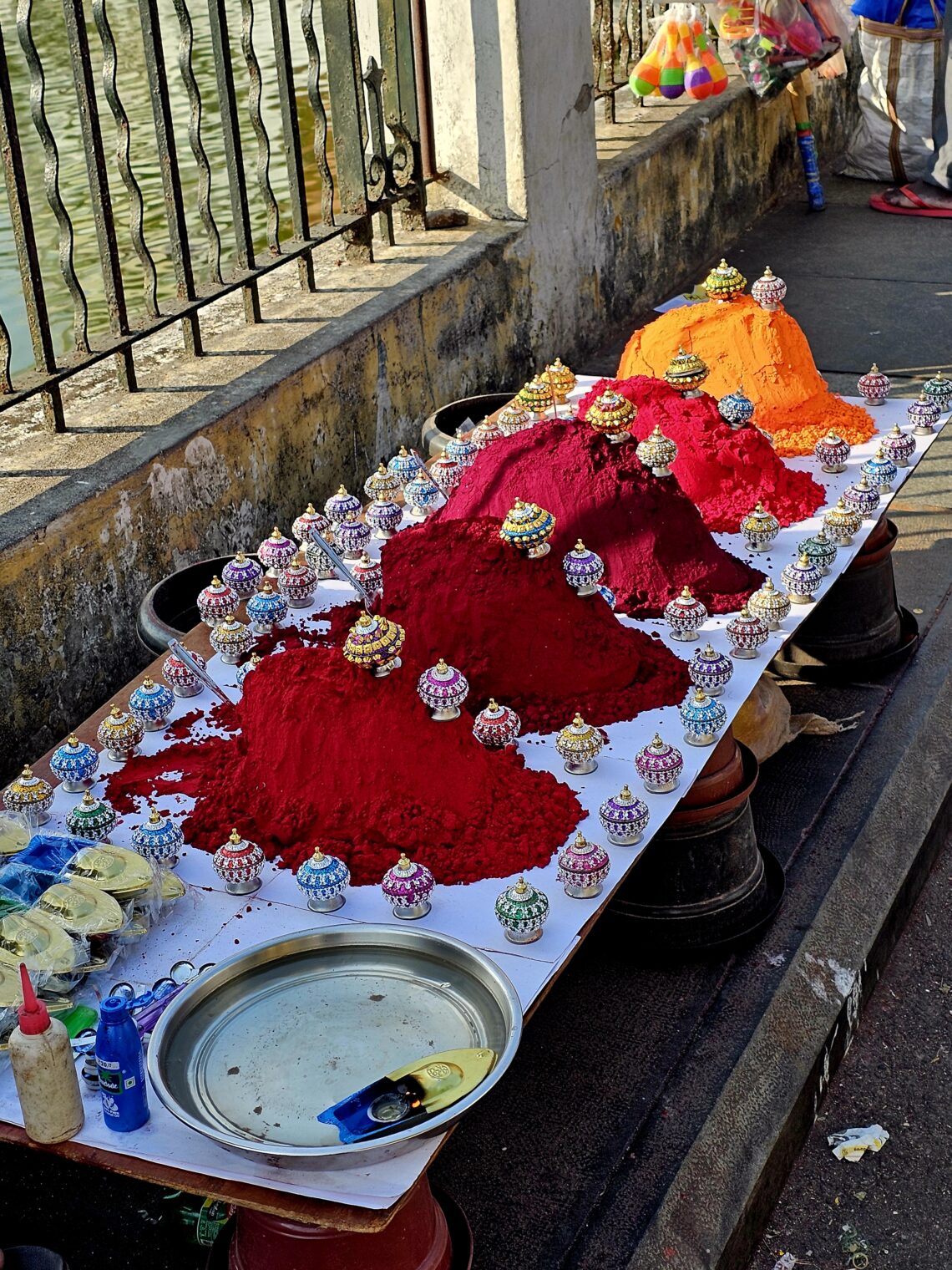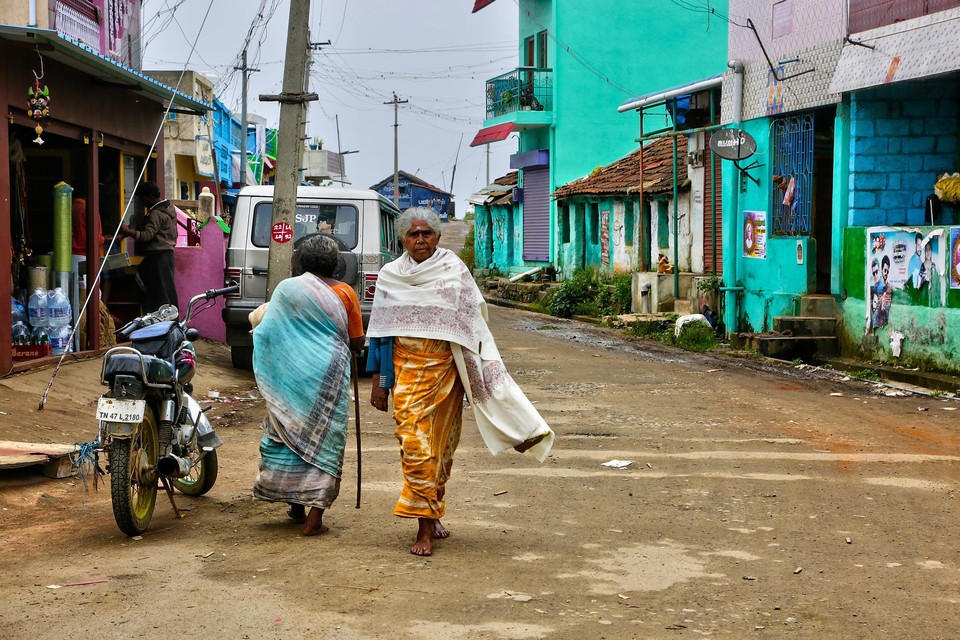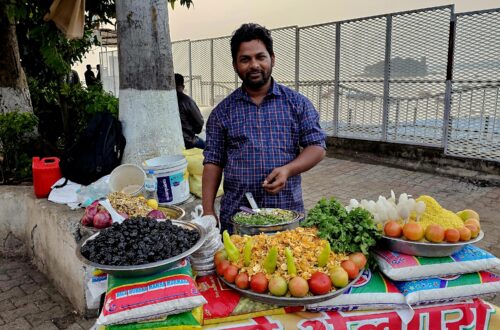
India, een grootmacht met soms griezelige groeipijnen (De Standaard – 25/11/2023)
English translation below
Women stroll in Kodaikanal, in the Indian state of Tamil Nadu. — © getty

De grootste bevolking, de grootste groei: India lijkt klaar voor een grote sprong voorwaarts. Zo beloftevol als de economische toekomst lijkt, zo duister zijn de politieke en maatschappelijke demonen waarmee de ontluikende wereldmacht nog altijd worstelt.
Nico Tanghe
Wie grote steden bezoekt zoals Mumbai, Pune, Ahmedabad, Ghandinagar en Bangalore, merkt het meteen: India richt zich economisch volop naar het Westen. Trager dan buurland China, maar toch. Nu de geopolitieke omstandigheden China veel minder aantrekkelijk maken als goedkoop productieland, openen westerse bedrijven massaal nieuwe fabrieken in India. Premier Narendra Modi, een diplomatiek evenwichtskunstenaar, speelt daar slim op in. Terwijl China steeds meer op ramkoers ligt met de VS en bij uitbreiding het Westen, slaagt India er schijnbaar moeiteloos in om niemand voor het hoofd te stoten.
Dat biedt kansen voor ondernemers uit het Westen. Geïnteresseerde bedrijven kunnen zich in India richten op een snelgroeiende binnenlandse markt van bijna 450 miljoen mensen, van wie het lagere segment voor het eerst echt kan en wil consumeren. Die nieuwe consumenten vormen een gigantische groep van jonge, goedkope arbeidskrachten waaruit ondernemers ogenschijnlijk eindeloos kunnen putten. De jonge, gretige Indiërs leven vooral op het platteland en moeten via de economie uit de armoede worden getrokken – net zoals dat begin deze eeuw gebeurde in China.
Indiase psychologie
Het land heeft ook een performant onderwijssysteem. In sommige grote steden blijft Engels een belangrijke voertaal en digitaal is India meer dan ooit wereldwijd een van de koplopers. Daardoor kunnen westerse investeerders bijvoorbeeld via de smartphone rechtstreeks en relatief goedkoop verzekeringen aan de gewone bevolking aanbieden. Dat lukt vooral wanneer de bedrijven hun huiswerk maken en zich aanpassen aan de Indiase cultuur, waarin traditie, waarden en familie erg belangrijk blijven.
Maar zo modern en vooruitstrevend India is op het vlak van technologie en ruimtevaart, zo ouderwets, hiërarchisch en patriarchaal is het land op maatschappelijk vlak. Indiërs zijn terecht fier op hun cultuur, diversiteit en geschiedenis. Begrijpelijk wijzen ze op de hypocrisie van het Westen, dat soms nodeloos hooghartig blijft wijzen met het vingertje. Dat neemt niet weg dat in grote delen van het land de maatschappij ver achter loopt in belangrijke zaken zoals netheid, publieke veiligheid voor vrouwen, gezondheidszorg en ja, zelfs basishygiëne zoals toiletten.
Land van contrasten
Het is een van de vele tegenstellingen in het complexe India. Op het vlak van handel bijvoorbeeld, blijft Modi slim schipperen tussen meer openheid en protectionisme. Terwijl India zich via goedkope arbeid, gulle subsidies en directe buitenlandse investeringen op de kaart probeert te zetten als ‘de nieuwe fabriek van de wereld’, is de Modi-regering tegelijk niet vies van puur protectionisme.
Een voorbeeld? Om de gigantische Indiase landbouwsector te beschermen, lobbyt Modi bij de Wereldhandelsorganisatie om voor sommige gewassen importsubsidies te mogen invoeren. Het is een gevoelig thema dat tijdens de komende Europees-Indiase onderhandelingen over een nieuw handelsakkoord aan bod zal komen. Dat is niet verwonderlijk, want volgend jaar vinden in India nationale verkiezingen plaats en de landbouw is nog altijd veruit de grootste werkgever. 42 procent van de Indiërs werkt vandaag op het platteland.
Olympische Spelen 2036
Dat is niet het enige voorbeeld van staatsingrepen in India. Tal van economische sectoren zijn nog corporatistisch georganiseerd. De bedrijven in die sectoren worden door de Indiase staat juridisch beschermd tegen buitenlandse concurrenten. Zo zijn westerse investeerders die een bank of advocatenkantoor willen openen, verplicht een joint venture op te starten met een lokale speler. Dat maakt buitenlandse investeringen in die sectoren niet erg rendabel. Op dat vlak versoepelen de regels, maar het proces zit nog maar in het beginstadium.
Toch doet Modi er veel aan om op tal van domeinen het groeiproces te versnellen. Met grote evenementen zoals de organisatie van de G20 en het WK cricket, die de voorbije maanden plaatsvonden in India, en de massale uitrol van grote infrastructuurwerken wil Modi zijn land op de wereldkaart zetten. Tijdens ons bezoek aan India hield de top van het Internationaal Olympisch Comité zijn jaarlijkse vergadering in Mumbai, met op de agenda de pas ingediende kandidatuur van India voor de organisatie van de Olympische Spelen in 2036. Ook dat doet denken aan het China van begin deze eeuw.
Het blijft afwachten of India daarin zal slagen, want de uitdagingen van het gigantische land zijn groot en de werven talrijk. Niet alleen letterlijk – zo is de treininfrastructuur nog altijd zeer verouderd en is er een groot gebrek aan moderne containerhavens – maar vooral op het vlak van mentaliteit. Opmerkelijk: de opvallendste tegenstelling in India – die tussen extreem rijk en extreem arm –is vandaag nauwelijks een bron van onrust. De gewone Indiër heeft er ogenschijnlijk mee leren leven. Dat Modi probeert om de scherpe kanten van die extreme ongelijkheid te verzachten met gratis graan en subsidies voor gas om te koken, heeft daar mogelijk iets mee te maken.
Etnische democratie
Andere werven lijken op dit moment dringender. De bureaucratie en de corruptie verminderen wel in India, maar blijven, zeker lokaal, iets om rekening mee te houden. Voor tal van zaken blijven allerlei documenten en stempels nodig. Zowat overal tijdens onze reis zagen we publieke bordjes met het veelzeggende opschrift: ‘Wij aanvaarden hier geen smeergeld.’
Politiek blijft de sleutelvraag of de ‘etnische democratie’ waarvoor Modi bekendstaat, uiteindelijk niet zal verzanden in een autocratisch bewind zoals vandaag in China. De complexe politieke structuur in India – waarbij veel macht regionaal is verankerd op niveau van de staten – en de onafhankelijkheid van het Indiase gerecht, zouden dat in theorie moeten verhinderen. Maar de almaar hardere aanpak van de media en etnische minderheden, doen critici als professor/schrijver Ashok Swain dan weer besluiten dat hindoenationalistisch India gevaarlijk aan het afglijden is naar een politiestaat.
Economisch is de grootste werf wellicht de beperkte aanwezigheid van vrouwen op de arbeidsmarkt, die bijna nergens ter wereld zo laag ligt als in India. Dat komt deels door een gebrek aan publieke veiligheid voor vrouwen, en deels door het alomtegenwoordige en economisch verlammende kastensysteem – al probeert de overheid daaraan wel te werken. Een van de grote Indiase conglomeraten, Tata, probeert het beeld van jonge vrouwen te veranderen met een promotiefilmpje waarin een luxueuze SUV door vrouwen wordt geassembleerd. Maar ook hier is de weg naar emancipatie nog lang.
Toekomst versus verleden
Welke plaats India in de nieuwe multilaterale wereldorde zal innemen, valt niet te voorspellen. Net zomin als er een antwoord is op de vraag of de duurste diamant ter wereld, de Koh-i-Noor, ooit van het Britse kroonjuweel zal gehaald worden en naar thuisland India zal terugkeren.
Zeker is dat India op dit moment voor een strategisch kruispunt staat. Daarbij zal niet alleen de overheid in Delhi moeten kiezen tussen verleden en toekomst, dat zal ook de bevolking moeten doen. Hoe gigantisch die stap is voor de meesten van de 1,4 miljard inwoners van India, zie je nergens beter dan in de spreidstand in de overheidscommunicatie. Modi zet in elke speech India in de markt als ‘a country reaching for the moon and beyond’, een grootmacht in de wereld. Tegelijk lanceerde hij vorige maand een landelijke advertentiecampagne waarin zijn regering oproept om het alomtegenwoordige zwerfvuil op te ruimen. Of hoe naar de maan reizen in India vandaag nog altijd begint met het collectief schoonvegen van de straten en pleinen in eigen dorp en stad.

The largest population, the fastest growth: India appears ready for a significant leap forward. As promising as the economic future seems, the political and societal demons that the emerging world power still grapples with remain dark.
Nico Tanghe
Anyone visiting major cities such as Mumbai, Pune, Ahmedabad, Ghandinagar, and Bangalore immediately notices: India is fully aligning its economy with the West. Slower than its neighbour China, but still. Now that geopolitical circumstances make China much less attractive as a cheap manufacturing hub, Western companies are opening new factories in India on a massive scale. Prime Minister Narendra Modi, a diplomatic tactician, is cleverly capitalizing on this. While China increasingly clashes with the US and, by extension, the West, India seems to effortlessly avoid offending anyone.
This presents opportunities for Western entrepreneurs. Interested companies can focus on a rapidly growing domestic market of nearly 450 million people in India, of whom the lower segment can now genuinely afford and want to consume. These new consumers constitute a massive group of young, inexpensive labor from which entrepreneurs can seemingly draw endlessly. The young, eager Indians mainly reside in rural areas and need to be lifted out of poverty through the economy, much like what happened in China earlier this century.
Indian Psychology
The country also has an efficient education system. In some major cities, English remains an important language, and digitally, India is more than ever one of the global leaders. This allows Western investors, for example, to offer insurance directly to the general population through smartphones, efficiently and relatively cheaply. This works especially well when companies do their homework and adapt to Indian culture, where tradition, values, and family remain crucial.
But as modern and progressive as India is in terms of technology and space exploration, it is equally old-fashioned, hierarchical, and patriarchal on a societal level. Indians rightfully take pride in their culture, diversity, and history. Understandably, they point out the hypocrisy of the West, which sometimes unnecessarily remains condescending. However, in large parts of the country, society lags far behind in crucial areas such as cleanliness, public safety for women, healthcare, and even basic hygiene like toilets.
Land of Contrasts
This is one of the many contradictions in complex India. In terms of trade, for example, Modi continues to navigate smartly between more openness and protectionism. While India seeks to establish itself as ‘the new factory of the world’ through cheap labor, generous subsidies, and direct foreign investment, the Modi government is simultaneously not averse to pure protectionism.
An example? To protect the massive Indian agricultural sector, Modi lobbies the World Trade Organization to allow import subsidies for certain crops. This is a sensitive issue that will come up during the upcoming European-Indian negotiations on a new trade agreement. That’s not surprising, as national elections are scheduled in India next year, and agriculture is still by far the largest employer. 42 percent of Indians currently work in rural areas.
Olympic Games 2036
This is not the only example of state intervention in India. Numerous economic sectors are still corporatist. Companies in these sectors are legally protected by the Indian state against foreign competitors. So, Western investors looking to open a bank or law firm are required to start a joint venture with a local player. This makes foreign investments in these sectors not very profitable. The rules are easing in this regard, but the process is still in its early stages.
Nevertheless, Modi is doing a lot to accelerate the growth process in many areas. With major events such as hosting the G20 and the Cricket World Cup in India in recent months, and the massive rollout of major infrastructure projects, Modi aims to put his country on the world map. During our visit to India, the International Olympic Committee held its annual meeting in Mumbai, with India submitting its bid to host the Olympic Games in 2036. This, too, echoes China at the beginning of this century.
It remains to be seen whether India will succeed in this endeavor because the challenges for the giant country are significant and the construction sites numerous. Not only literally – the train infrastructure is still very outdated, and there is a severe lack of modern container ports – but especially in terms of mentality. Remarkably, the most striking contradiction in India – between the extremely rich and extremely poor – is hardly a source of unrest today. The ordinary Indian seemingly learned to live with it. Modi’s attempts to soften the sharp edges of this extreme inequality with free grain and subsidies for cooking gas might have something to do with it.
Ethnic Democracy
Other construction sites seem more urgent at the moment. While bureaucracy and corruption are decreasing in India, they remain something to contend with, especially locally. Numerous documents and stamps are still required for various matters. Almost everywhere during our trip, we saw public signs with the telling inscription: ‘We do not accept bribes here.’
Politically, the key question remains whether the ‘ethnic democracy’ for which Modi is known will ultimately not degenerate into an autocratic regime as is the case in China today. The complex political structure in India – where much power is regionally anchored at the state level – and the independence of the Indian judiciary should, in theory, prevent this. However, the increasingly harsh treatment of the media and ethnic minorities leads critics like professor/writer Ashok Swain to conclude that Hindu nationalist India is dangerously sliding towards a police state.
Economically, perhaps the most significant construction site is the limited presence of women in the labor market, which is almost nowhere in the world as low as in India. This is partly due to a lack of public safety for women and partly due to the ubiquitous and economically paralyzing caste system – although the government is working on it. One of the major Indian conglomerates, Tata, is trying to change the image of young women with a promotional video in which a luxury SUV is assembled by women. But here, too, the road to emancipation is still long.
Future vs. Past
It is impossible to predict the place India will occupy in the new multilateral world order. Just as there is no answer to whether the world’s most expensive diamond, the Koh-i-Noor, will ever be removed from the British crown jewel and returned to its home country, India.
What is certain is that India is currently at a strategic crossroads. Not only will the government in Delhi have to choose between the past and the future, but so will the population. The enormity of this step for most of India’s 1.4 billion inhabitants is best seen in the wide stance of government communication. In every speech, Modi markets India as ‘a country reaching for the moon and beyond,’ a global power. At the same time, last month, he launched a nationwide advertising campaign in which his government calls for the cleanup of ubiquitous litter. This shows that the journey to the moon in India today still begins with the collective sweeping of streets and squares in one’s own village and city.





